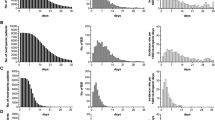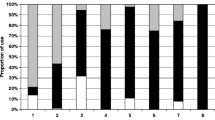Abstract
A total of 399 consecutive episodes of bloodstream infections in adult patients with haematologic malignancies and solid tumours were evaluated prospectively over a 26-month period, with the aim of determining the clinical characteristics and the microbiological profile of the patients relative to neutrophil count. The overall 30-day mortality rate was 32% (35% in non-neutropenic patients vs. 26% in neutropenic patients, p=0.05). Main diagnoses were solid tumours (33%) and lymphoma (29%). Most of the episodes of bloodstream infection (58%) occurred in non-neutropenic patients. Acute leukaemia and bone marrow transplantation predominated in the neutropenic group. Non-neutropenic patients tended to be older and to have a higher frequency of solid tumours and advanced or uncontrolled diseases. Indwelling central venous catheters were present in 51% of the episodes, with a predominance of long-term catheters in neutropenic haematologic patients. Concomitant infections were observed more frequently in non-neutropenic patients. There were 1,040 noninfectious comorbid conditions, most of which were present in non-neutropenic patients. The causative pathogens were predominantly gram-negative bacilli (56%). Escherichia coli and Klebsiella pneumoniae were isolated more frequently from neutropenic patients, while Staphylococcus aureus and Acinetobacter spp. were more frequent in non-neutropenic patients. Seventy-four percent of the episodes of candidaemia occurred in patients with central venous catheters, with non-albicans strains predominating. The results of this study highlight the heterogeneity of cancer patients with bloodstream infections and the value of stratifying risk factors and aetiologic agents according to neutrophil count.
Similar content being viewed by others
References
Elting LS, Rubenstein EB, Rolston KVI, Bodey GP (1997) Outcomes of bacteremia in patients with cancer and neutropenia: observation from two decades of epidemiological and clinical trials. Clin Infect Dis 25:247–259
Wisplinghoff H, Cornely AO, Moser S, Bethe U, Stützer H, Salzberger B, Fätkenheuer G, Seifert H (2003) Outcomes of nosocomial bloodstream infections in adult neutropenic patients: a prospective cohort and matched case-control study. Infect Control Hosp Epidemiol 24:905–911
Pittet D, Tarara D, Wenzel RP (1994) Nosocomial bloodstream infection in critically ill patients. JAMA 271:1598–1601
Spengler RF, Greenough WE III (1978) Hospital costs and mortality attributed to nosocomial bacteremias. JAMA 240:2455–2458
Wisplinghoff H, Seifer H, Wenzel RP, Edmond MB (2003) Current trends in the epidemiology of nosocomial bloodstream infections in patients with hematologic malignancies and solid neoplasms in hospitals in the United States. Clin Infect Dis 36:1103–1110
Jugo J, Kennedy R, Crowe MJ et al (2002) Trends in bacteraemia on the haematology and oncology units of a UK tertiary referral hospital. J Hosp Infect 50:48–55
Velasco E, Byington R, Martins CAS, Schirmer M, Dias LCM, Gonçalves VMSC (2003) Prospective evaluation of the epidemiology, microbiology, and outcome of bloodstream infections in hematologic patients in a single cancer center. Eur J Clin Microbiol Infect Dis 22:137–143
Velasco E, Byington R, Martins CAS, Schirmer M, Dias LCM, Gonçalves VMSC (2004) Bloodstream infections surveillance in a cancer center: a prospective look at clinical microbiology aspects. Clin Microbiol Infect 10:542–549
Garner JS, Jarvis WR, Emori TG, Horan TC, Hughes JM (1988) CDC definitions for nosocomial infections. Am J Infect Contr 16:128–140
Sickles E, Greene W, Wiernik PH (1975) Clinical presentation of infection in granulocytopenic patients. Arch Intern Med 135:715–719
Mermel LA, Farr BM, Sherertz RJ, Raad II, O’Grady N, Harris J, Craven DE (2001) Guidelines for management of intravascular catheter-related infections. Clin Infect Dis 32:1249–1272
Karnofsky DA, Burchenot JH (1949) The clinical evaluation of chemotherapeutic agents in cancer. In: MacLead CM (ed) Evaluation of chemotherapeutic agents. Symposium, Microbiology Section, New York Academy of Medicine, New York, New York, 1948. Columbia University Press, New York, pp 191–205
World Health Organization (1979) Handbook for reporting results of cancer treatment. WHO, Geneva, pp 15–22
Miller JM, O’Hara CM (1995) Substrate utilization systems for the identification of bacteria and yeast. In: Murray PR, Baron EJ, Pfaller MA, Tenover FC, Yolken RH (eds) Manual of clinical microbiology. American Society for Microbiology, Washington, District of Columbia, pp 103–109
National Committee for Clinical Laboratory Standards (2000) Methods for dilution antimicrobial susceptibility tests for bacteria that grow aerobically. Approved standard M7-A5. NCCLS, Wayne, Pennsylvania
Klastersky J (2004) Management of fever in neutropenic patients with different risks of complications. Clin Infect Dis 39:S32–S37
Pompei P, Charlson ME, Ales K, MacKenzie CR, Norton M (1991) Relating patient characteristics at the time of admission to outcomes of hospitalization. J Clin Epidemiol 44:1063–1069
Elting L, Cooksley C, Chambers M, Cantor S, Manzullo E, Rubenstein E (2003) The burdens of cancer therapy: clinical and economic outcomes of chemotherapy-induced mucositis, measurement, epidemiology, and consequences for patients. Cancer 98:1531–1539
Diekema DJ, BootsMiller BJ, Vaughn TE, Woolson RF, Yankey JW, Ernst EJ, Flach SD, Ward MM, Franciscus CL, Pfaller MA, Doebbeling BN (2004) Antimicrobial resistance trends and outbreak frequency in United States hospitals. Clin Infect Dis 38:78–85
Winston DJ, Lazarus HM, Beveridge RA, Hathorn JW, Gucalp R, Ramphal R, Chow AW, Ho WG, Horn R, Feld R, Louie TJ, Territo MC, Blumer JL, Tack KJ (2001) Randomized, double-blind, multicenter trial comparing clinafloxacin with imipenem as empirical monotherapy for febrile granulocytopenic patients. Clin Infect Dis 32:381–390
Feld R, DePauw B, Berman S, Keating A, Ho W (2000) Meropenen versus ceftazidime in the treatment of cancer patients with febrile neutropenia: a randomized double-blind trial. J Clin Oncol 18:3690–3698
Extermann M (2000) Measuring comorbidity in older cancer patients. Eur J Cancer 36:453–471
Juthani-Mehta M, Quagliarello VJ (2004) Prognostic scoring system for infectious diseases: their applicability to the care of older adults. Clin Infect Dis 38:692–696
Rossini F (1996) Prognosis of infections in elderly patients with hematological diseases. Support Care Cancer 4:46–50
Cosgrove AS, Carmeli Y (2003) The impact of antimicrobial resistance on health and economic outcomes. Clin Infect Dis 36:1433–1437
Lautenbach E, Patel JB, Bilker WB, Edesltein PH, Fishman NO (2001) Extended-spectrum β-lactamase-producing Escherichia coli and Klebsiella pneumoniae: risk factors for infection and impact of resistance on outcomes. Clin Infect Dis 32:1162–1171
Kang CI, Kim SH, Park WB, Lee KD, Kim HB, Oh Md, Kim EC, Choe KW (2004) Bloodstream infections caused by Enterobacter species: predictors of 30-day mortality rate and impact of broad-spectrum cephalosporin resistance on outcome. Clin Infect Dis 39:812–818
Vidal F, Mensa J, Almela M, Olona M, Martinez JÁ, Marco F, Lopez MJ, Soriano A, Horcajada JP, Gatell JM, Richart C (2003) Bacteraemia in adults due to glucose non-fermentative gram-negative bacilli other than P. aeruginosa. Q J Med 96:227–234
Martino R, Gomes L, Pericas R, Salazar R, Solá C, Sierra J, Garau J (2000) Bacteraemia caused by non-glucose fermenting gram-negative bacilli and Aeromonas species in patients with hematological malignancies and solid tumours. Eur J Clin Microbiol Infect Dis 19:320–323
Viscoli C, Girmenia C, Marinus A, Collete L, Martino P, Vandercam B, Doyen C, Lebeau B, Spence D, Krcmery V, De Pauw B, Meunier F, and the Invasive Fungal Infection Group of the EORTC (1999) Candidemia in cancer patients: a prospective, multicenter surveillance study by the Invasive Fungal Infection Group (IFIG) of the European Organization for Research and Treatment of Cancer (EORTC). Clin Infect Dis 28:1071–1079
Beck-Sagué CM, Jarvis WM, and the National Nosocomial Infections Surveillance System (1993) Secular trends in the epidemiology of nosocomial fungal infections in the United States, 1980–1990. J Infect Dis 167:1247–1251
Acknowledgements
We are grateful to Dr. Márcio Soares for his active participation in this manuscript. We thank the Clinical Microbiology and Mycology Laboratory at Hospital do Câncer, National Cancer Institute, for technical assistance.
Author information
Authors and Affiliations
Corresponding author
Additional information
This work was presented in part at the 7th International Symposium on Febrile Neutropenia, 27–29 January 2005, Seville, Spain.
Rights and permissions
About this article
Cite this article
Velasco, E., Byington, R., Martins, C.A.S. et al. Comparative study of clinical characteristics of neutropenic and non-neutropenic adult cancer patients with bloodstream infections. Eur J Clin Microbiol Infect Dis 25, 1–7 (2006). https://doi.org/10.1007/s10096-005-0077-8
Published:
Issue Date:
DOI: https://doi.org/10.1007/s10096-005-0077-8




